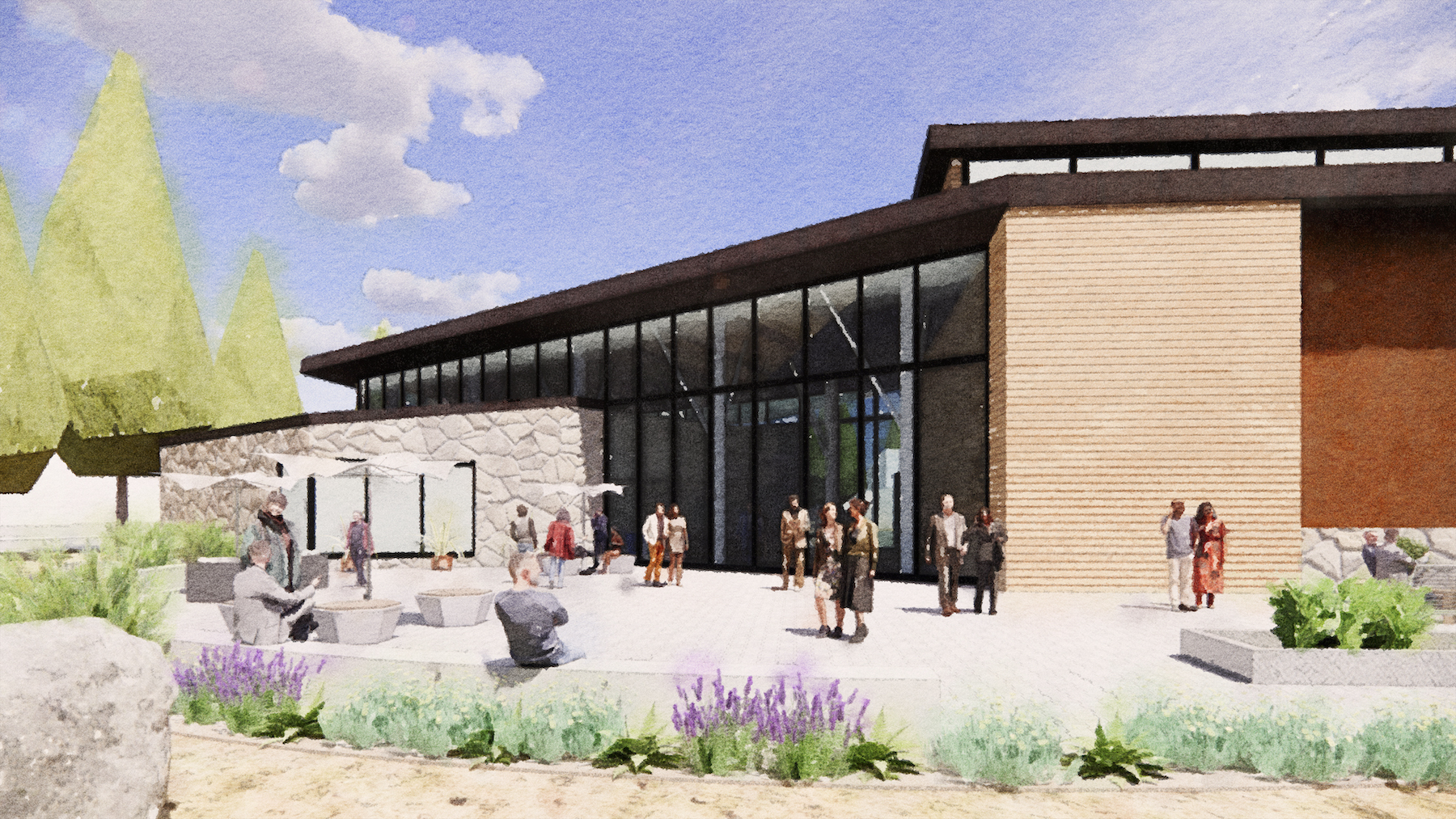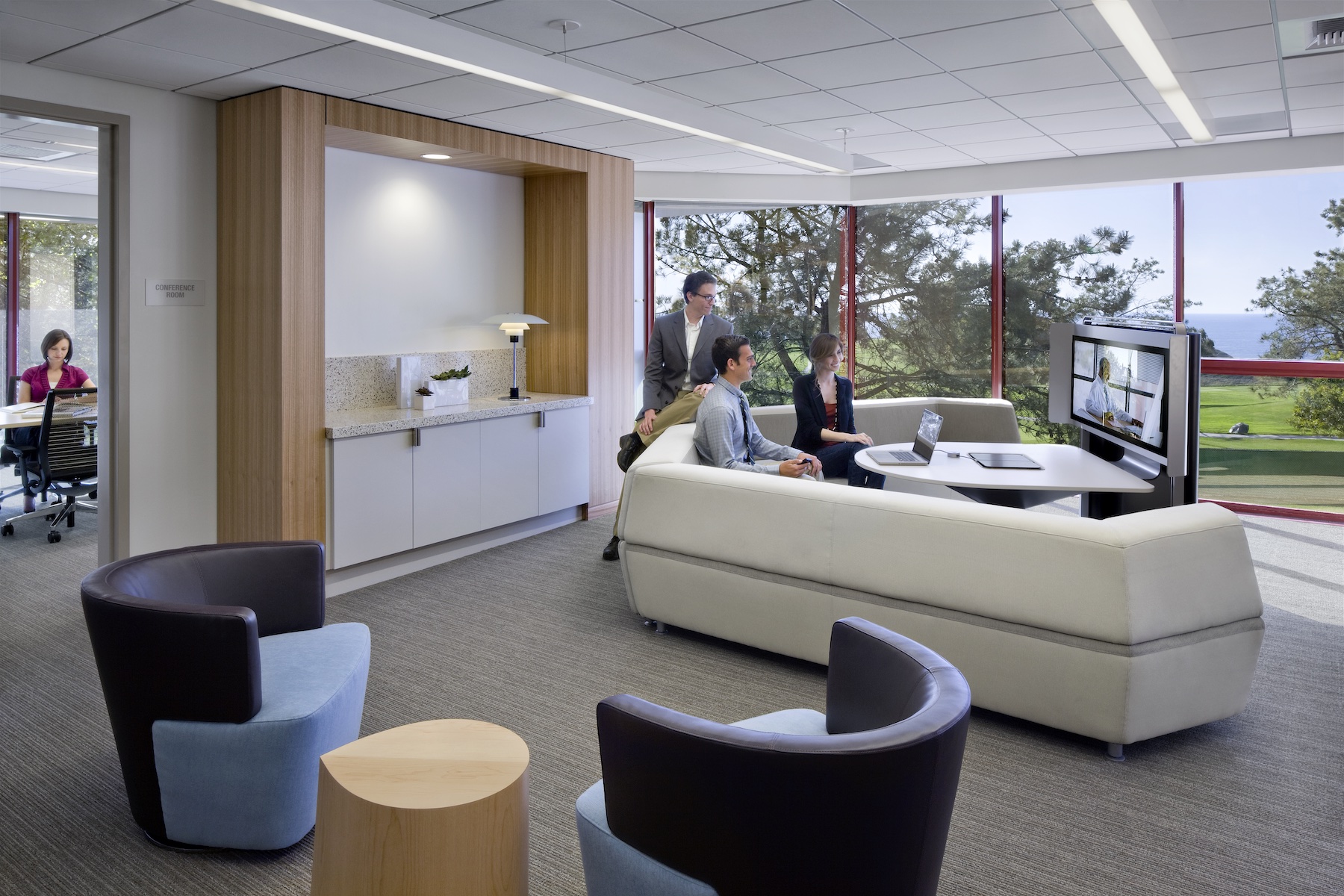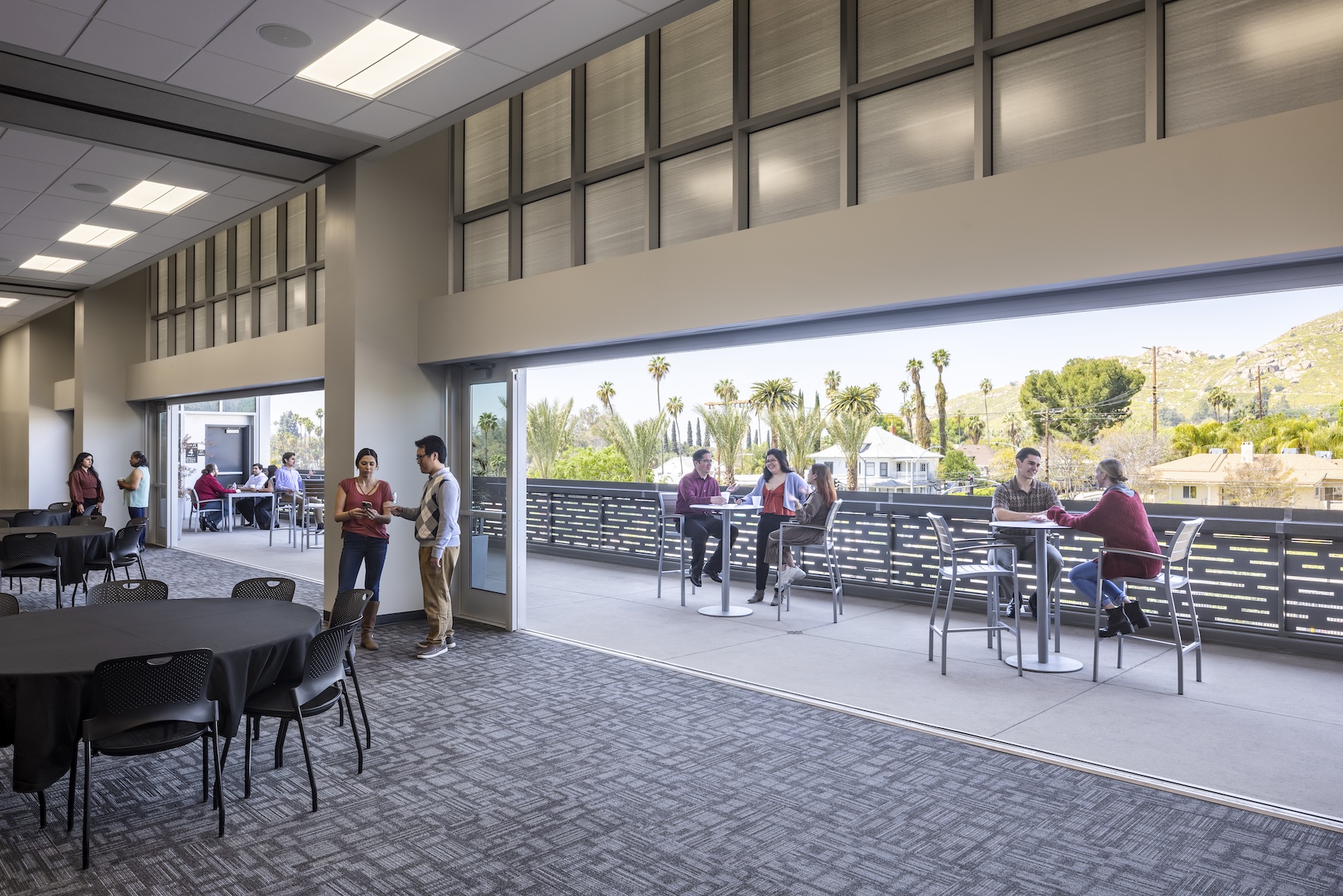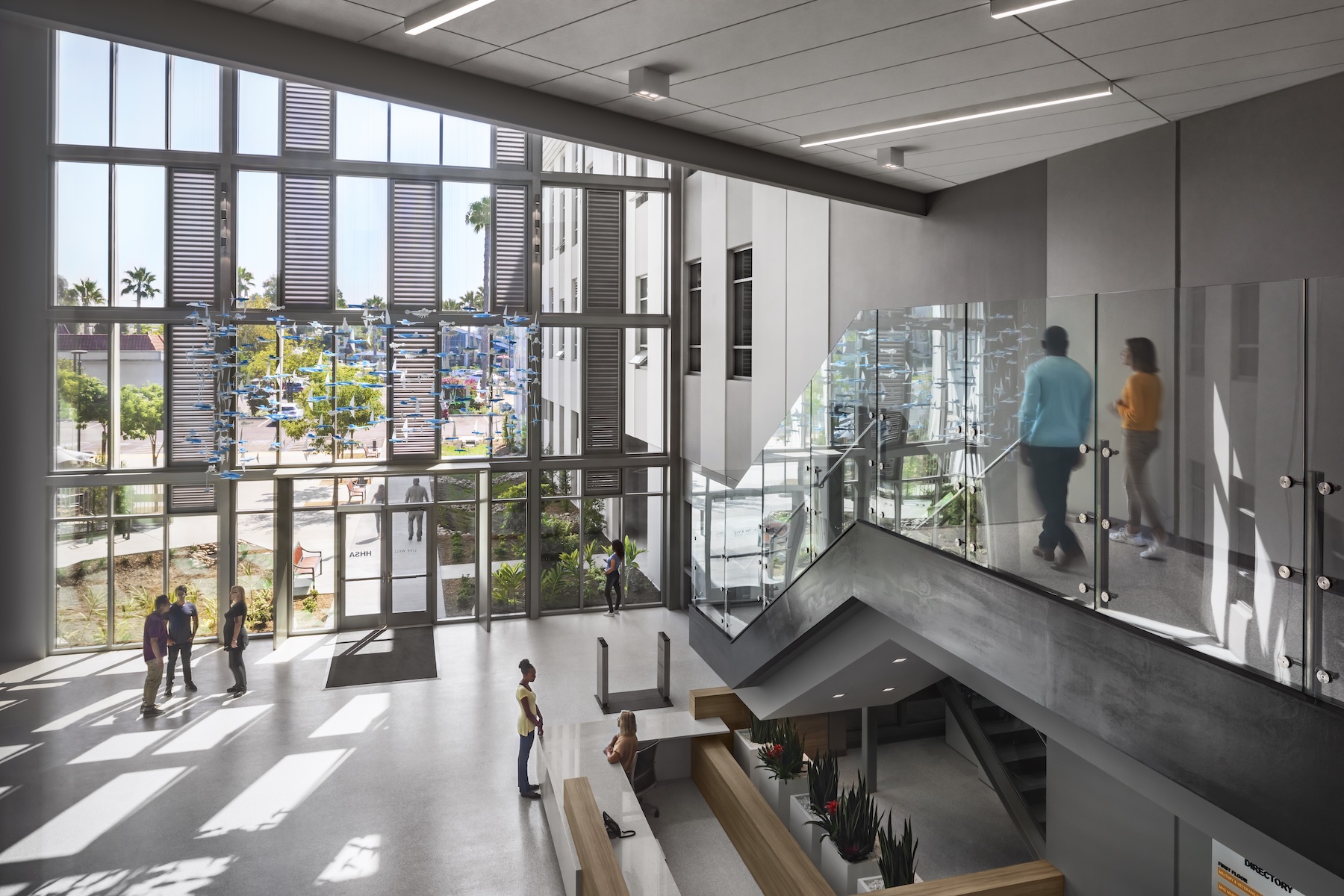The wake of the coronavirus pandemic has presented an opportune moment to re-evaluate and renew physical workplaces as employees return to them.
“The link between good workplace design and productivity is unmistakable,” states HMC Architects in its recently released report, titled “Designing for Wellness and Good Governance,” which focuses on design work done for public-sector clients by the firm’s six studios in California.
The report’s authors note that workplace design for the public sector comes with challenges. “As today’s office landscape becomes less hierarchical and younger staff more interested in a collaborative environment, employers must evolve to meet the needs of the next generation. Public optics, safety, many departments, and unique bidding processes must be considered.”

Those challenges are compounded by the shifting toward hybrid work and how offices must now function. “We are leaving behind a workplace that operates like a machine, where roles and responsibilities are clearly defined and predictable,” the authors write. “Our new future is a workplace that functions like an ecosystem and requires adaptability and unpredictable roles and responsibilities.”
The 28-page report, which can be downloaded from here, aims to present a “blueprint” to craft workplaces “that transcend functional utility and metamorphose into nurturing hubs of growth, connectedness, and mutual success.”
A holistic approach to wellness design

HMC Architects spells out what offices need to be doing today, starting with empowering people to do their best work. Cost-effective environments that blend flexibility, health, and wellness have a better chance at attracting new talent, enhancing employee satisfaction, and fortifying retention rates.
“Wellness is good business,” states the authors, pointing to studies that show that employee absenteeism is reduced, productivity increases, and employee turnover is significantly reduced. “Employee health and wellness investments make people feel valued and often encourage them to invest in their physical and mental well-being.”
However, creating a healthier work environment does not necessarily mean relocation or a complete revamp of existing space; there are cost-effective changes that can have significant impacts, such as bringing in new furniture and lighting for better comfort, temperature, mood, openness and flexibility. HMC says that prioritizing occupants’ thermal comfort is a “cornerstone” of a productive and content working environment
HMC’s solutions are holistic, encompassing the nurturing of wellness through healthier in-office nutritional choices and amenities such as fitness centers, private respite rooms, and access to outdoor recreational areas. “Investing in these purposeful amenities underscores a resolute commitment to cultivating a work environment that is supportive and engaging,” the report states. “Such an environment reflects a genuine concern for the welfare of employees.”
Case studies showcase different design approaches
The report homes in on seven public-sector “case studies” throughout California that amplify some of its general wellness points:
•The County of San Diego North Coastal Live Well Health Centers, whose interior design takes advantage of daylight and fresh air;
•The University of California San Diego North Torrey Pines Living and Learning Neighborhood, whose design balances privacy and collaboration in office spaces;
•Kaiser Permanente’s Fontana Medical Center, a Medical Office Building whose interior design includes biophilia inspired by nature;
•Riverside Office of Education Conference Center, whose design (elevates collaboration and comfort to encourage success;
•Los Angeles County Department of Public Works’ landscape Improvements that include a wellness garden which redefines the workplace experience;
•Mammoth Lakes Civic Center that reshapes the city hub; and
•The Ontario City Hall Annex that creates an office oasis. Along the building’s periphery, open office ergonomic workstations bask in daylight and offer glimpses of the outdoors, facilitated by intelligent sun control mechanisms that subdue glare. Internal offices, adorned with generous glazing, harness natural light cascading within.

The Riverside case study is an example of how design brings disparate elements together. The building’s ground floor serves as nexus for communal engagement, with an interplay between indoor and outdoor spaces. There’s a fusion of private space and open workspaces, and an expansive conference room within the building’s core. Overhead glass and sliding doors unveil a terrace that extends the conference space to an inviting outdoor area, commanding panoramic views of the neighboring landscape.
Related Stories
| Aug 11, 2010
Carpenters' union helping build its own headquarters
The New England Regional Council of Carpenters headquarters in Dorchester, Mass., is taking shape within a 1940s industrial building. The Building Team of ADD Inc., RDK Engineers, Suffolk Construction, and the carpenters' Joint Apprenticeship Training Committee, is giving the old facility a modern makeover by converting the existing two-story structure into a three-story, 75,000-sf, LEED-certif...
| Aug 11, 2010
Office complex will incorporate a bit of Summit, N.J., history
Greenock Capital Management and CB Richard Ellis have broken ground on the 46,570-sf Claremont Corporate Center in Summit, N.J. The two-story, Class A office complex will incorporate the adjacent turn-of-the-century Risk Mansion, family home of Dr. William H. Risk, who settled in Summit in 1873. The mansion will be the focus of the facility, with new, modern offices and below-grade parking cons...
| Aug 11, 2010
RMJM unveils design details for $1B green development in Turkey
RMJM has unveiled the design for the $1 billion Varyap Meridian development it is master planning in Istanbul, Turkey's Atasehir district, a new residential and business district. Set on a highly visible site that features panoramic views stretching from the Bosporus Strait in the west to the Sea of Marmara to the south, the 372,000-square-meter development includes a 60-story tower, 1,500 resi...
| Aug 11, 2010
LEED Platinum office complex opens in Morristown
The new headquarters for the Geraldine R. Dodge Foundation in Morristown, N.J., is on track to achieve LEED Platinum certification from the U.S. Green Building Council. Designed by Minno & Wasko Architects and Planners, Lambertville, N.J., the $9.5 million building includes four floors of office space and an adjacent 791-space parking deck.
| Aug 11, 2010
'Feebate' program to reward green buildings in Portland, Ore.
Officials in Portland, Ore., have proposed a green building incentive program that would be the first of its kind in the U.S. Under the program, new commercial buildings, 20,000 sf or larger, that meet Oregon's state building code would be assessed a fee by the city of up to $3.46/sf. The fee would be waived for buildings that achieve LEED Silver certification from the U.
| Aug 11, 2010
Goettsch Partners wins design competition for Soochow Securities HQ in China
Chicago-based Goettsch Partners has been selected to design the Soochow Securities Headquarters, the new office and stock exchange building for Soochow Securities Co. Ltd. The 21-story, 441,300-sf project includes 344,400 sf of office space, an 86,100-sf stock exchange, classrooms, and underground parking.
| Aug 11, 2010
Green HQ going up in Miami
Formgroup, Coral Gables, Fla., has been commissioned by communications company CIMA Telecom to design its 24,000-sf headquarters in Miami. The nine-story, LEED Gold pre-certified office building will get 25% of its power from solar panels and will minimize energy usage with the help of automated window shades and occupancy sensors.
| Aug 11, 2010
Manhattan's Pier 57 to be transformed into $210 million cultural center
LOT-EK, Beyer Blinder Belle, and West 8 have been selected as the design team for Hudson River Park's $210 million Pier 57 redevelopment, headed by local developer Young Woo & Associates. The 375,000-sf vacant passenger ship terminal will be transformed into a cultural center, small business incubator, and public park, including a rooftop venue for the Tribeca Film Festival.
| Aug 11, 2010
Manhattan's latest boutique hotel will be LEED Silver certified
New York-based developer Tribeca Associates has commissioned Brennan Beer Gorman Architects to design its latest mixed-use office and boutique hotel at 330 Hudson Street. Located in the downtown Hudson Square area of Manhattan, the LEED-Silver development will involve the redevelopment of a historic, eight-story warehouse building into 292,000 sf of office space, 15,000 sf of retail space, and ...
| Aug 11, 2010
NASA plans federal government's greenest building
NASA is set to break ground on what the agency expects to be the highest-performing building in the federal government's portfolio. Named Sustainability Base, the building at Ames Research Center in Sunnyvale, Calif., will be a showplace for sustainable technologies, featuring some of the agency's most advanced recycling and intelligent controls technologies originally developed to support NASA...







